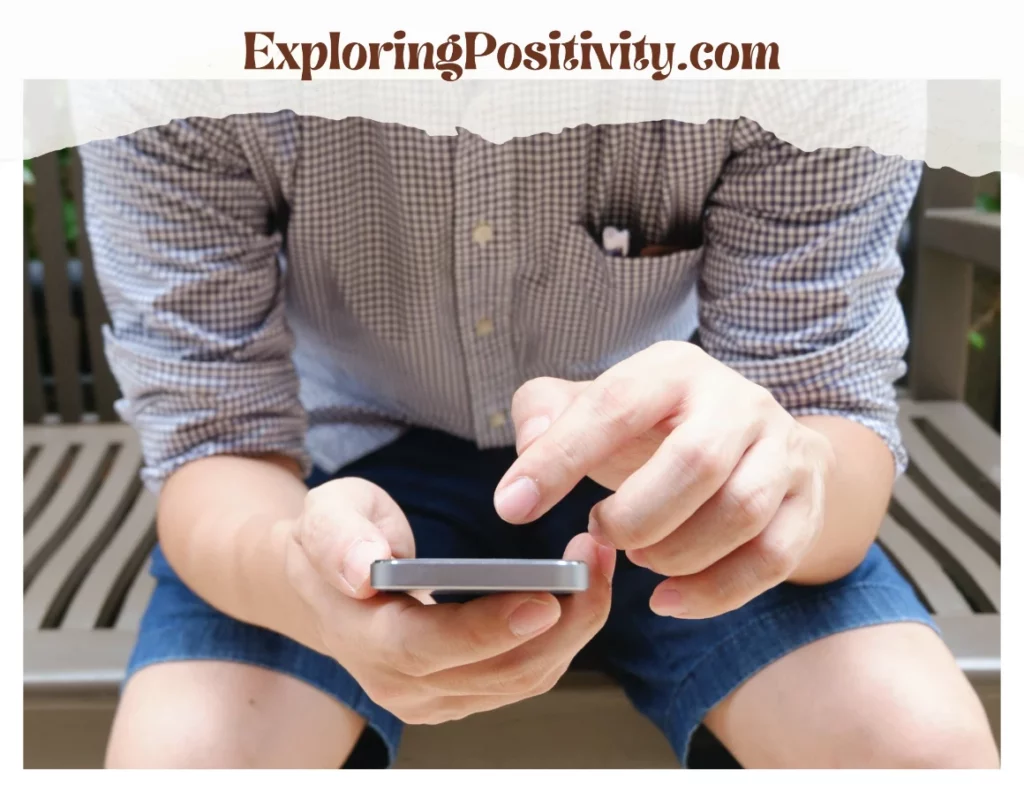An avoidant attachment style typically develops early in life when a child does not receive adequate emotional support or affection from primary caregivers.
As adults, people with an avoidant attachment style tend to be uncomfortable with intimacy and have difficulty depending on others. They prize independence and self-sufficiency, avoiding too much closeness in relationships.
Regarding communication, avoidants often distance themselves, require more space, and can come across as cold or detached to protect themselves. This makes building close bonds challenging. Their deactivating strategies can leave partners feeling frustrated, confused, or abandoned.
While having an avoidant attachment causes issues in many relationships, the behavior is ultimately rooted in emotional self-preservation. With insight and proper communication techniques tailored to avoidants’ needs, forming secure attachments is possible.
Texting (How to Text an Avoidant) is convenient but lacks critical emotional cues. For avoidants who struggle to express themselves in close relationships, texting can exacerbate communication issues. Thoughtfulness, patience, and applying avoidant attachment theory create better text conversations.
First, give avoidant space between responses. Bombarding them with too frequent texts can cause withdrawal. Allow extra time for replies before following up. Next, keep communication focused. Avoidants recoil from small talk or texts focused solely on connecting emotionally. Stick to logistics and facts.
It also helps to avoid needy, emotionally loaded language. Stay composed and confident in your messages—don’t plead for responses or affection. Along the same lines, respect their boundaries and need for autonomy. If an avoidant says they need space, honor that request.
While these tips protect avoidants’ vulnerabilities, you can still foster intimacy safely through text. Occasional expressions of care are acceptable if worded carefully.
For instance, “Thinking of you” acknowledges your interest without demanding reciprocation. Find the balance between showing support and coming on too strong.
What is Avoidant Attachment Style?
Avoidant attachment style refers to a pattern of behavior and self-perception characterized by difficulty depending on others due to a deep-seated distrust that needs will be met.
It typically originates from inadequate nurturing and affection during childhood, leading to independence, self-sufficiency, and maintaining emotional distance being prioritized over intimacy in relationships.
Individuals with an avoidant attachment style desire high autonomy and self-reliance. They view themselves as fully independent and dismiss the importance of close relationships.
Avoidants find it challenging to rely on others for practical or emotional support and unconsciously suppress natural impulses for intimacy.
Avoidants have trouble recognizing their partners’ needs or perspectives when in relationships. Direct communication regarding the connection status tends to be avoided or approached reluctantly.
Avoidants also use deactivating strategies when they feel a partner makes too many emotional demands, creating a frequent distancing-pursuing dynamic.
Origin of Avoidant Attachment
Avoidant attachment often stems from insufficient caregiver attunement and affection during infancy or childhood. Infants require reliable nurturing and care from primary attachment figures to feel safe enough to explore their environment. Avoidant attachment forms when need fulfillment is inconsistent, negligent, or rejected.
As a result, emotional distance becomes equated with safety, while vulnerability and intimacy prove frightening. These children must rely heavily on themselves to achieve basic needs, carrying painful memories of neglect forward through life and gravely distrusting relationship partners’ goodwill.
Avoidants in Relationships
The deep discomfort avoidants feel depending on others breeds intimacy, support, and communication difficulties in romantic partnerships. Avoidants struggle to let their guard down and can seem detached, dismissive, or overly independent even when committed.
During the conflict, avoidants use distancing mechanisms to suppress natural anxieties over the threat of losing the relationship. Partners often feel shut out both physically and emotionally.
Pursuing behaviors by romantic partners can be interpreted as attempts to control or dominate by avoidants. Over time, the accumulating damage leads partners to feel unloved and abandoned.
Challenges of Dating an Avoidant
Partners of avoidants often suffer from low self-esteem, high anxiety, and anger about feeling neglected. They perceive the avoidant as reluctant to address issues concerning intimacy and the relationship’s health. This breeds resentment, hopeless pursuer-distancer patterns, and a stifling of mutual affection.
Avoidants struggle to understand others’ emotions and can seem aloof or dismissive even when claiming to commit long-term. Partners feel unable to rely on avoidants for support during hard times.
Textbook deactivating strategies like needing sudden space or broken plans leave partners feeling confused and unable to trust. Confronting avoidants about issues commonly produces withdrawals or leaves problems unresolved.

Texting Etiquette with Avoidants
Give avoidant space between messages and avoid pressure or neediness when texting. Besides, many etiquette issues need to be addressed.
Be Concise Yet Warm
When texting avoidants, balance brevity with occasional warmth. Avoidants feel uncomfortable with effusive messages full of emotion. But staying completely detached threatens the relationship.
Keep text conversations focused on making plans, sharing information, and light check-ins. Lengthy chatty exchanges may prompt deactivation. However, brief yet thoughtful messages communicate caring. For instance, “I appreciate you” or “Thinking good thoughts your way” shows you hold them in mind without demanding engagement.
Structured, logistical conversations feel safer for avoidants. Discuss practical matters like scheduling, location details, or task updates. Sprinkle in positivity by noting something you look forward to doing together. Streamlined communication helps avoidants handle intimacy at their own pace.
Give Them Space to Respond
Avoidants require extra autonomy concerning response times. Bombarding an avoidant with frequent, urgent-sounding texts causes them to withdraw. Set the expectation upfront that responses may be sporadic or delayed.
Wait several hours or even days before following up on important matters. For casual check-ins, allow extra time before taking a lack of engagement personally. Signal that sporadic replies are perfectly acceptable by mirroring slower response rates yourself.
When avoidants reach out after a longer gap, respond warmly without criticism. Comments like “Was wondering how your week is going!” or “Haven’t heard from you in a bit, everything okay?” are better than expressions of hurt. This model gives relationship discussions room to breathe.
Avoid Pressure and Neediness
The ultimate pitfall when texting avoidants is appearing clingy or emotionally needy. This activates alarm bells, signaling a loss of independence or entrapment. Even subtle comments like “I wish we could talk more” or frequently asked to make plans could prompt deactivation.
Stick to discussing practical matters requiring decisions. Share positive updates or exciting tidbits from your day without demanding reciprocation. Practice patience in the face of distant responses or longer delays between texts. Adjust your expectations around availability rather than pressuring for more contact.
Texting can bolster intimacy if you convey strength, respect for autonomy, and emotional stability. Let your actions show trust in avoidants’ caring, even if irregularly expressed. Remove demands for constant connectivity. With composure and brevity, make texting feel safe.
Boundaries and Expectations While Texting
Discovering effective ways to text an avoidant individual involves understanding the importance of setting clear boundaries and managing expectations in your conversations. “Let’s explore some boundaries in detail.
Discuss Relationship Roles Openly
Have an upfront conversation about each other’s needs and limitations. Explain your desire for regular contact and emotional availability patiently. Ask what Concrete level of text communication makes them comfortable.
Focus the talk on practical matters like ideal response time, frequency of casual check-ins, or the types of texts that feel intrusive. Provide reassurance you respect their boundaries while communicating yours. Outline areas of flexibility and compromise around things like good morning/night texts or making weekend plans.
While this talk requires emotional vulnerability, avoidants shun it and couch it as a logistical discussion. Emphasize crafting mutually agreeable communication guidelines, not demanding intimacy progress unilaterally. With patience and compassion, an organized relationship talk removes pressure.
Set Communication Expectations
After mutually establishing an ideal contact frequency, reinforce those expectations moving forward. For instance, agreeing to catch up midweek and consistently texting Tuesday lunch updates holds you both accountable.
Frame requested responses in low-pressure yet hopeful language, like “No worries if busy, but let me know if Friday works?” If they exceed the stated availability, positively reinforce it. Say things like “Really enjoy our random check-ins” or “Thanks for getting back to me on this so quickly!”
Approach deviations calmly using “I statements” – “I worry when I don’t hear back all weekend” reads better than accusations. But avoid emotionally charged conversations over text; have them in person.
Understand Their Texting Habits
Recognize avoidants’ texting patterns reflect self-protective instincts, not disregard for you. Their earlier conditioning requires coping mechanisms hampering intimacy. Compassionately accepting limitations facilitates trust and consistency.
For instance, avoid interpreting longer response delays as clues that the relationship is endangered. Assure avoidants through actions and words. You don’t demand instant contact without exception. Patiently adapt text conversations to their rhythms rather than insisting on matching yours.
Over time, avoidants feel safer leaning on others’ support if they don’t worry about losing independence or being shamed for deactivation reflexes. Stable partners lessen relationship anxiety, allowing organic intimacy growth.
Give Reassurance if Needed
Avoidants prize self-reliance, but occasional reassurance provides comfort. Offer encouragement by noting specific qualities or relationship aspects you appreciate about them. Comments like “You really came through helping me last week” or “I’m so thankful for evenings together” can mean a lot.
Verbalizing admiration and gratitude directly combats avoidants’ core shame over “needing” someone. It helps lessen secret fears. Their flaws make them undeserving of love. Send thoughtful texts naming strengths, talents, or simple acts of everyday caring that avoidants provide.
Just be careful with compliments involving emotional displays or overt vulnerability. For avoidants, softer words land best, so phrases like “You really make me smile” come across as more genuinely caring than gushing prose.

positive communication strategies
Learn practical and positive communication techniques to connect with an avoidant individual through thoughtful texting approaches that promote understanding and build a stronger relationship. Let’s read a few positive communication strategies in detail.
Validate Their Need for Autonomy
Avoidants feel most secure when given latitude governing their availability. Validate that their sporadic responses reflect a healthy assertion of boundaries, not emotional distance. Even if you miss more contact, reinforce that you respect their texting terms by not pushing further access.
Say things like “No problem, just let me know when you’re up for chatting” if conversations lag. Or “I appreciate you communicating where you’re at right now” if they request more space. Smooth over delays in answering by sending a thoughtful meme and then patiently awaiting replies.
You can note a desire for more closeness while validating autonomy: “I always enjoy our long talks but don’t want to ever pressure you.” This caring tone eases avoidants’ fears needing connection somehow diminishes their strength or independence in the relationship.
Use Positive Reinforcement
Notice and praise communication milestones to motivate intimacy progress. If an avoidant partner initiates a problematic conversation, thank them for the effort and reinforce how much it means to you.
Comments like “It makes me feel trusted when you open up about things bothering you” or “I loved our talk last night, it really meant a lot” encourage further risks. Avoid critiquing the quantity or quality of their disclosures—focus solely on sharing itself.
You can also reinforce faster response times by remembering essential dates or reciprocal questions about your life. Say things like, “It was so nice getting your rapid replies last night!” or “I appreciate you asking how my day went.”
Keep Conversations Light and Upbeat
Serious, heavy talks over text often prompt deactivation in avoidants. Keep the overall tone of messages fairly surface-level and upbeat. Have deeper discussions requiring emotional sharing face-to-face.
Pepper everyday banter with humor, exciting news, or amusing observations to spark a safe connection. Share funny memes, quirky work mishaps, or recent examples you thought of them fondly.
Avoid drilling into relationship problems over text, which can feel like pressure. Instead, use messages to coordinate enjoyable activities, highlight shared interests, or remind avoidants how valued they are.
Focus on Planning Future Dates/Meetups
Make setting up pleasant experiences together the primary text conversation focus on avoidants. Brainstorm fun weekend ideas during more effortless weekday banter. Share enticing options like concerts, new bars, or seasonal events to generate excitement.
Pose date specifics cheerfully yet casually to avoid demands: “Saw an Italian food fest this Saturday if that tempts you at all!” Follow-ups might read, “Or you could pick an evening next weekend, no pressure!” Discussing anticipated good times emphasizes enjoyable intimacy ahead rather than criticizing deficiencies.
Use check-ins about concrete plans to display investment also: “I’m looking forward to our museum trip together whenever it works for you.” These create pleasant security, knowing you desire future closeness.
Use Humor and Banter Appropriately
Studies demonstrate that shared laughter and amusement build bonds by triggering endorphins and feelings of compatibility. With avoidants’ caution around intimacy, lightheartedness makes connecting safer.
Send amusing videos, witty memes, or silly jokes fitting the relationship’s banter style. Just ensure humor stays good-natured, not sarcastic teasing covering up resentment. Follow laughs with sincere affection like “Too funny, totally something you’d do, babe.”
Playfully bantering over text also encourages authentic self-expression and gives glimpses into your personality. Just keep the overall tone warm, not poking fun. Teasing can quickly cross hurtful lines without visual cues and vocal technique. Laughter should lift spirits, not mask antagonism.
Emotions and Conflicts When Texting
Let’s explore the dynamics of emotions and conflicts when texting an avoidant and discover practical insights to handle these situations gracefully and with understanding.
Tread Lightly Around Emotional Issues
Avoidants feel overwhelmed by emotionally charged conversations, especially over text, lacking nonverbal cues. Tread exceptionally carefully, bringing up vulnerabilities, fears, or irritation even if you have legitimate needs for reassurance or comfort.
Keep expressions of heavier emotions simple and completely non-accusatory. For example, “Feeling kind of anxious and could use some support” reads far better to an avoidant than dramatic venting. Follow quickly with, “But no pressure if you’re not up for talking right now.”
If you must address a concerning behavior over text, use neutral, “I statements” focused solely on facts, not judgments. For instance, “I felt worried when my call wasn’t answered all weekend. Can we talk about communication expectations moving forward?” avoids attacking characters.
Don’t Take Their Detachment Personally
Remind yourself regularly that withdrawal or texting detachment represents avoidants managing fears, not disregarding the relationship. Intellectually accepting their deactivated states as involuntary coping reflexes makes them less painful.
Rather than lashing out over a lack of emotional availability, politely acknowledge your need isn’t currently being met. For example, “I understand if talking feels like too much right now, but I could really use some support. Let me know if you become available to connect more.”
Suppress knee-jerk reactions to ghosting or delays so conversations avoid devolving into blame. If you receive one-word answers to thoughtful messages, don’t reactively punish them by mirroring coldness. Simply give them more breathing room until they can warm back up.
Give Them Time and Space to Process
Let avoidants entirely withdraw if they indicate needing complete radio silence rather than “chasing” them. Send a caring text like, “I’m here whenever you’re ready to talk again,” then don’t follow up persistently. Match their timetables, re-establishing contact even if you miss them terribly.
Even for more minor conflicts, allow extra time for avoidants to work through high anxiety. Let them respond on their timing when calmer rather than demanding a rushed resolution. Set expectations like, “No need to analyze everything now. Just ping me whenever you’re ready to smooth things over.”
With sensitive conflicts, tangibly demonstrate you are staying with them while respecting the requested distance. Keep statements of affection simple, like, “Thinking of you and hope to reconnect soon.” Removing pressure helps avoidants process feelings without heightened fears of losing you.

Maintaining a Secure Presence When Texting
Ensuring a secure and reassuring presence in your text messages to an avoidant person involves employing techniques that promote trust and emotional safety in your conversations.
Be Reliable and Consistent
Avoidants rely heavily on partners to provide a stable anchor, even if they seem self-sufficient. Regularly demonstrate dependability and predictability through actions. Keep committed plans, check in consistently without much fluctuation, and promptly address practical matters requiring decisions.
Reliability provides a sense of safety, allowing for gradual emotional intimacy growth. Follow through on discussed availability expectations, even if avoidants fall short. For instance, maintain weekly Friday date texts even if enthusiasm is sometimes matched.
Over time, modeling stability and commitment helps avoidants take risks and open up more. Small consistency markers communicate you represent security, not chaos and uncertainty in their lives.
Don’t Make Demands or Try to Change Them
Avoid setting rigid expectations around vulnerability or pushing for premature relationship advances. State clearly if specific needs require accommodation for continuing the relationship healthily. But focus requests around tangible actions, not demanding wholesale personality change.
For example, ask for scheduled check-ins rather than insisting they divulge innermost fears. Say, “It would mean a lot if we could talk on Wednesday nights.” Reasonable, specific relationship adjustments feel far less threatening than being told they are intimate enough for you.
Ultimately, you chose to date an avoidant, fully aware of ingrained emotional limitations. While kind support can help avoidants safely access emotions, their core wiring remains on self-protection. Accept what they can realistically give.
Balance Closeness With Independence
Preserve avoidants’ sense of autonomy whenever reasonably possible. After closer moments, pull back a bit in giving space rather than clinging to newfound intimacy.
For instance, after an intense weekend getaway, say, “That was so special. Let me know if you want company or just your own time this week,” rather than immediately planning the next date. Adjusting the closeness dial honors their vulnerability thresholds.
Know When To Walk Away
If an avoidant remains unwilling to address core needs despite multiple caring attempts or continues violating stated boundaries, leave. Control what you can – your own choices.
Explain you’re at an impasse that’s no longer tenable if basic requirements for intimacy and availability go unaddressed. Outline clearly which expectations require a meeting to continue the relationship. Consider involving a couple’s counselor before ultimately walking away.
Leaving signals that your needs matter, too. While attachment styles explain behavior, they don’t excuse causing harm. Emphasize wanting compromise before exiting, then follow through to protect yourself and your peace. :
Final Thoughts – How to Text an Avoidant
Texting avoidant romantic partners requires insight, empathy, and maintaining personal boundaries. Adjust communication without expecting overnight intimacy transformation or abandoning reasonable needs.
Protect avoidants’ autonomy by giving wide response latitude. But set some availability expectations and then consistently model them. Limit emotional conversations via text, but sprinkle in warmth and reassurance. Address conflicts patiently, focusing on resolutions, not attacking character.
Ultimately, you cannot single-handedly undo years of defensive relational habits. Working alongside avoidant partners in caring and understanding smoothes growth. But refuse to accept indefinite stonewalling or neglect because “that’s how they are.”
When dating avoidants, know your needs and limitations. Reflect on previous relationships to spot unhealthy dynamics or savior complex tendencies. Then, uphold boundaries around unacceptable behaviors.
For instance, if sporadic texting over 48 hours triggers anxiety, discuss reasonable expectations. If avoidants violate agreements, revisit them before resentment builds, even seeking couple’s therapy.
With clarity on needs, you may correctly attribute rejection to your worthiness of love. Remember, poor treatment stems from avoidants’ inner turmoil.
Their dysfunction does not define your value. Approach texting avoidants as an exercise in calibrated care – not designated crisis interventionist. You cannot talk anyone into secure attachment if they feel unsafe revealing vulnerabilities.
Instead, offer consistent emotional refuge at the avoidants’ pace. By modeling reliability, they also learn to trust texts as a safe communication forum.
Meet avoidants where they reside on the intimacy spectrum rather than expecting their emotional capacity to match yours immediately. Growth unfolds gradually in relationships with an avoidant. Accept reasonable compromises, assert your equally valid needs, and lead with compassion.
Avoidants require more autonomy and space than most. Slower response times or occasionally unanswered texts allow them to control interaction frequency. It’s not necessarily a reflection on you but on their self-protective attachment style.
No. Chasing down responses or reacting emotionally reinforces fears of engulfment. Be patient, and don’t take it personally. Let avoidants engage in conversation in their own time without added pressure.
Tread very cautiously here as emotional conversations can prompt avoidants to withdraw further. Have sensitive talks face-to-face whenever possible. If addressing a concern via text can’t wait, use neutral language focused on resolvable behaviors, not attacking character.
You can’t force vulnerability before someone feels safe. Earn their trust slowly through reliability and consistency. Occasionally, open up first about lighter matters to model secure emotional sharing. But don’t demand immediate reciprocation, given their wiring.




